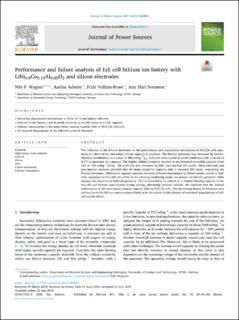| dc.contributor.author | Wagner, Nils Peter | |
| dc.contributor.author | Asheim, Karina | |
| dc.contributor.author | Vullum-Bruer, Fride | |
| dc.contributor.author | Svensson, Ann Mari | |
| dc.date.accessioned | 2020-11-26T14:08:12Z | |
| dc.date.available | 2020-11-26T14:08:12Z | |
| dc.date.created | 2019-07-31T09:05:15Z | |
| dc.date.issued | 2019 | |
| dc.identifier.citation | Journal of Power Sources. 2019, 437 1-10. | en_US |
| dc.identifier.issn | 0378-7753 | |
| dc.identifier.uri | https://hdl.handle.net/11250/2689826 | |
| dc.description.abstract | The influence of the lithium inventory on the performance and degradation mechanism of NCA||Si cells operating at a third of the theoretical silicon capacity is analysed. The lithium inventory was increased by electrochemical prelithiation to a value of 300 mAhg−1(Si). Full-cells were cycled at harsh conditions with a cut-off of 4.4 V to maximise the capacity. The higher lithium inventory resulted in an increased reversible capacity from 163 to 199 mAhg−1(NCA). The cycle-life was increased by 60% and reached 245 cycles. Three-electrode and post-mortem analyses revealed that the main reason for capacity fade is repeated SEI repair, consuming the lithium inventory. Differential capacity analysis revealed different degradation of silicon anodes cycled in half-cells compared to full-cells. No shifts in the alloying/dealloying peaks are present in full-cell geometry while changes are observed in half-cell geometry. This is expected to be caused by a limited alloying capacity in the full-cell and lithium consumption during cycling, alleviating material stresses. We conclude that the lithium consumption is the main factor causing capacity fade in NCA||Si cells. The decreasing degree of lithiation over cycling due to the lithium consumption is likely to be the reason for the absence of structural degradations of full-cell cycled silicon. | en_US |
| dc.language.iso | eng | en_US |
| dc.publisher | Elsevier | en_US |
| dc.rights | Attribution-NonCommercial-NoDerivatives 4.0 Internasjonal | * |
| dc.rights.uri | http://creativecommons.org/licenses/by-nc-nd/4.0/deed.no | * |
| dc.subject | Lithium consumption | en_US |
| dc.subject | Failure mechanism | en_US |
| dc.subject | NCA | en_US |
| dc.subject | Silicon | en_US |
| dc.subject | Full-cell | en_US |
| dc.subject | High-energy Li-ion batteries | en_US |
| dc.title | Performance and failure analysis of full cell lithium ion battery with LiNi0.8Co0.15Al0.05O2 and silicon electrodes | en_US |
| dc.type | Journal article | en_US |
| dc.type | Peer reviewed | en_US |
| dc.description.version | publishedVersion | en_US |
| dc.rights.holder | © 2020 The Authors. Published by Elsevier B.V. This is an open access article under the CC BY-NC-ND license | en_US |
| dc.source.pagenumber | 1-10 | en_US |
| dc.source.volume | 437 | en_US |
| dc.source.journal | Journal of Power Sources | en_US |
| dc.identifier.doi | 10.1016/j.jpowsour.2019.226884 | |
| dc.identifier.cristin | 1713363 | |
| dc.relation.project | Norges forskningsråd: 255195 | en_US |
| cristin.unitcode | 7401,80,62,0 | |
| cristin.unitname | Bærekraftig energiteknologi | |
| cristin.ispublished | true | |
| cristin.fulltext | original | |
| cristin.qualitycode | 1 | |

